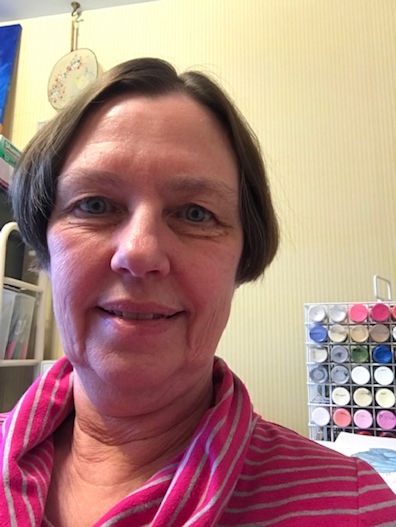Goo Gone
If you are purchasing a surface that is already pretty smooth, you may want to sand it first anyway; it will help the acrylic paint to adhere to the surface better. The rougher texture will give the acrylic something to cling to.
After the paint dried, I drew the face in using watercolor pencils and then used acrylic paint for painting the features and shading. Watercolor pencils work great; they easily blend in with the paint.
These are the colors that I used.
Pumpkin - Georgia Clay - kind of a burnt orange
Leaf - Avocado Dip
Stem - Fawn
I painted the eyes after the body of the pumpkin was completely painted.
Eyes, Nose, Mouth - Marigold - I chose a yellowish color to help it look like it was lit up on the inside. If you choose black for these features, you can add some gray highlights around the edges to add dimension.
I like using the Americana acrylic paint. It comes in convenient little bottles and has a pretty good consistency. Coverage is good with most colors. Reds can be more transparent than other colors. Covering with two layers will give the colors a more solid look.
When I did the highlights for the body, I mixed Georgia Clay paint with some of the Marigold. Then I dipped one corner of a flat brush in the Georgia Clay paint and the other corner of the brush in the mixture. Starting from the center, I painted vertical, curved stripes of the highlights, out toward the edges.
I also turned my brush around and painted the other side of the highlight using the same technique, painting the stripe towards the center of the pumpkin. This gave a more blended look on each side of the highlight.
I repeated this step for each curved section of the pumpkin that I wanted highlighted.
I did lighter highlights at the top of the pumpkin, slightly darker ones towards the middle, with no highlighting at the bottom.
How you decide to do this is up to you. Think about your pumpkins' face, where you want the light to look like it is shining on the pumpkin, and shade and highlight accordingly.
I added non-blended highlights around the bottom and sides of the mouth and eyes to give them more dimension. You can do this with a mix of Marigold with a tiny bit of Georgia Clay.
At the end, I added some fall accents to the leaves. You can dab on different colors with a paint brush or use a sea sponge. It helps to wet the sponge first, and then squeeze out the excess water before dipping it in the paint. You sponge will be more flexible then, and will also be easier to rinse out afterwards.
I hope you enjoyed this tutorial and have fun painting your own pumpkin face. It's so neat to get creative with pumpkin designs.
Cheryl Paton




No comments:
Post a Comment